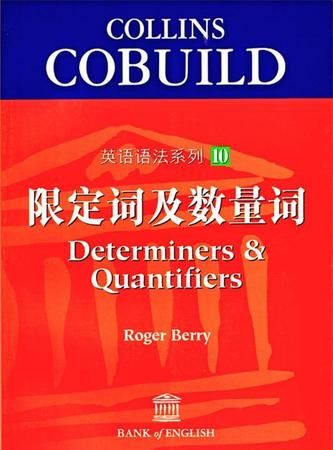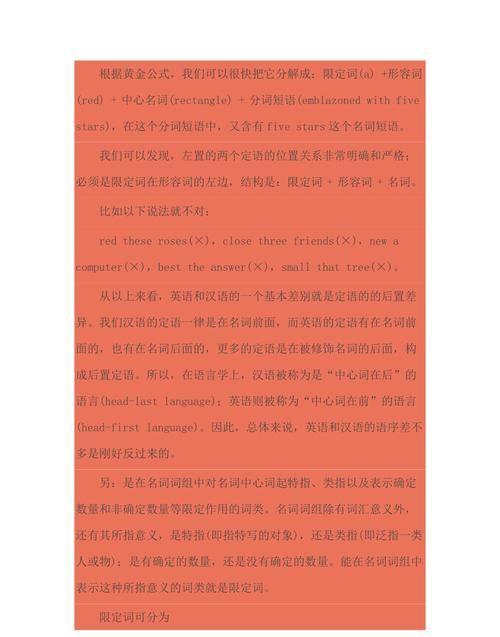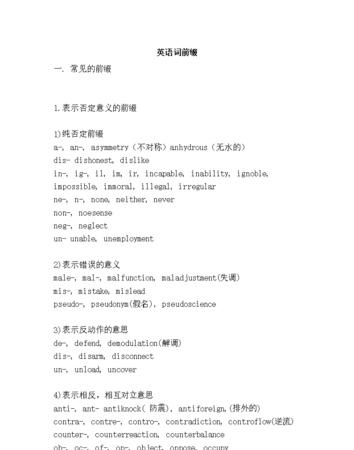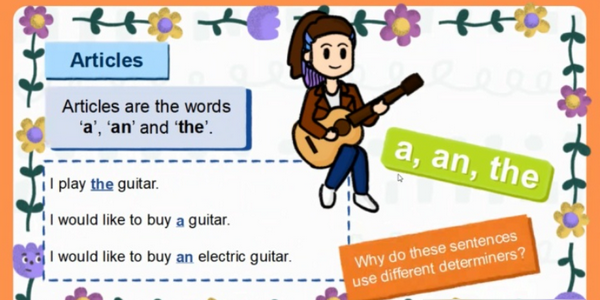本文目录
英语中如何区分前位,中位和后位限定词语
限定词可以分为前位限定词、中位限定词和后位限定词。
一、中位限定词
定冠词、不定冠词/ this / that / these / those / my / your / Merry's / my friend's / some / any / every / each / no /
在名词中心词之前只能出现一个这样的词。
a the boy a some boy
二、前位限定词
只能出现在某些中位限定词之前
1. all, both , half
eg. all the girls, half an hour
2. 倍数词 double, twice, three times
double the sum, twice my salary, three times the space 3. 分数词 one-third, one-fifth
One-third the time
4. such, what
such a surprise! What a fine day !
前位限定词是互相排斥的,如不能说all both girls。
all such 是个例外。
个别限定词有跨类现象。如such既属于前位限定词,又可归入后位限定词。由于它只是在 such a...和such an...这样的搭配中属于前位限定词。而在与其他限定词(some, any, no, all, few, another, other, many, one, two, etc)搭配时,such则是后位限定词,一律放在上述这些限定词的后面。
三、后位限定词
接在前位限定词或中位限定词后面
1. 基数词 my three children
2. 序数词 the first day, the last day
(一般序数词,last, next, past, another, additional, further)
3. 封闭类数量词 few people
4. 开放类数量词 a large number of people
希望我能帮助你解疑释惑。

英语中前位限定词有哪些
是后位限定词
按照限定词与限定词之间不同搭配位置,限定词可分为中位限定词(CENTRAL DETERMINER〕、前位限定词(PREDETERMINER〕和后位限定词(POSTDETERMINER〕.
a) 中位限定词包括a(n),the,zero; this,that,these,those;
my,your,etc; Merry's,my friend's;
some,any,no,every,each,either,neither,enough;
what(ever),which(ever),whose等
b) 前位限定词包括all,both,half; double,twice,three times,etc;
one-third,two-fifths,etc;
what,such,(a / an)等
c) 后位限定词包括one,two,three,etc; first,second,third,etc;
next,last,other,another,etc;
many,much,(a) few,(a) little,fewer,(the) fewest,less,(the) least,more,most;
several,plenty of,a lot of,lots of,a great / large / good number of,a great / good deal of,a large / small amount of; such等

在英语语法里面有陈述句有程序
冠词:a(n),the
指示代词:this,that,these,those
形容词性物主代词:my,your,his,her,our,etc
名词属格:Jim’s,my
mother’s
不定代词:some,any,no,every,each,either,neither,enough,etc
连接代词what(ever),which(ever),whose,etc
前位限定词包括:all,both,half;
double,twice,three
times,etc;
one-third,two-fifths,etc;
what,such,(a
/
an)等。
后位限定词包括:one,two,three,etc;
first,second,third,etc;
next,last,other,another,etc;
many,much,(a)
few,(a)
little,fewer,(the)
fewest,less,(the)
least,more,most;
several,plenty
of,a
lot
of,lots
of,a
great
/
large
/
good
number
of,a
great
/
good
deal
of,a
large
/
small
amount
of;
such等。
特点

英语中的限定词的顺序是怎样的呢
口诀:县官行令赦国才。
县:限定词,如a,the;
官:观点类的描述词,如beautiful,strong;
行:形状大小,如small,big;
令:年龄新旧,如old,young;
赦:颜色,如white,black;
国:国籍、产地等,如Chinese,French;
材:材料、质地,如wooden,metal。
例如:
She had a small round black wooden box.
He was a nice intelligent young man.

限定词的特点
从形式上看,大多数属于封闭性词类,并且具有相应的代词。
从位置上看,在名词短语中,它们位于形容词之前。
从功能上看,它们对其后的名词起限定作用。
从用法上看,在名词短语中,大多数限定词是相互排斥的,而形容词的使用从理论上说是没有数量限制的。
以上就是关于英文前位限定词,英语中如何区分前位,中位和后位限定词语的全部内容,以及英文前位限定词 的相关内容,希望能够帮到您。
